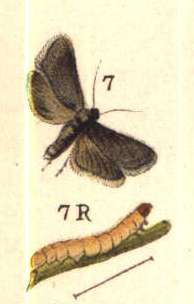
The Tortricidae are a family of moths, commonly known as tortrix moths or leafroller moths, in the order Lepidoptera. This large family has over 11,000 species described, and is the sole member of the superfamily Tortricoidea, although the genus Heliocosma is sometimes placed within this superfamily. Many of these are economically important pests. Olethreutidae is a junior synonym. The typical resting posture is with the wings folded back, producing a rather rounded profile.

Cydia is a large genus of tortrix moths, belonging to the tribe Grapholitini of subfamily Olethreutinae. Its distinctness from and delimitation versus the tribe's type genus Grapholita requires further study.

Pandemis cerasana, the barred fruit-tree tortrix, is a moth of the family Tortricidae.

Pandemis heparana, the dark fruit-tree tortrix or apple brown tortrix, is a moth of the family Tortricidae.

Grapholita funebrana, the plum fruit moth or red plum maggot, is a moth of the family Tortricidae. It is found in the Palearctic realm. Like many of its congeners, it is sometimes placed in Cydia.

Crocidosema plebejana, the cotton tipworm, is a tortrix moth, belonging to tribe Eucosmini of subfamily Olethreutinae. It is found today all over the subtropical and tropical regions of the world and even occurs on many oceanic islands – in Polynesia and Saint Helena for example – but has probably been accidentally introduced to much of its current range by humans. In addition, it is also found in some cooler regions, e.g. in Europe except in the east and north; this is probably also not natural, as it was, for example, not recorded in the British Isles before 1900.

A pheromone trap is a type of insect trap that uses pheromones to lure insects. Sex pheromones and aggregating pheromones are the most common types used. A pheromone-impregnated lure is encased in a conventional trap such as a bottle trap, delta trap, water-pan trap, or funnel trap. Pheromone traps are used both to count insect populations by sampling, and to trap pests such as clothes moths to destroy them.

Epiblema foenella, the white-foot bell, is a moth of the family Tortricidae.

Grapholita is a large genus of tortrix moths. It belongs to subfamily Olethreutinae, and therein to the tribe Grapholitini, of which it is the type genus.

Ditula angustiorana, the red-barred tortrix, is a moth of the family Tortricidae found in Africa, Asia, Europe and North Africa. Other common names are the fruit-tree tortrix and the vine tortrix. The moth was first described by Adrian Hardy Haworth in 1811.

Cydia duplicana is a small moth of the family Tortricidae. It is found in all across Europe, extending barely into Asia in the Transcaucasus, Turkestan and Kazakhstan.

Grapholitini is a tribe of tortrix moths.

Grapholita molesta, the oriental fruit moth or peach moth, is a moth of the family Tortricidae. It is native to China, but was introduced to Japan and North America and is now also found throughout of Europe, Asia and South America and in Hawaii, Morocco, Mauritius, South Africa, Australia and New Zealand

Pandemis corylana, the chequered fruit-tree tortrix, hazel tortrix moth, filbert tortricid or barred fruit tree moth, is a moth of the family Tortricidae. It is found from northern and central Europe to Siberia, Korea and Japan.

Grapholita janthinana, the hawthorn leafroller, is a moth of the family Tortricidae. It was described by Philogène Auguste Joseph Duponchel in 1843. It is found in most of Europe, except most of the Balkan Peninsula, Ukraine, Lithuania and Estonia. The habitat consists of hedgerows, gardens and woodland edges.

Grapholita discretana is a moth of the family Tortricidae. It was described by Maximilian Ferdinand Wocke in 1861. It is found in most of Europe, except Great Britain, Ireland, the Iberian Peninsula and most of the Balkan Peninsula.
















